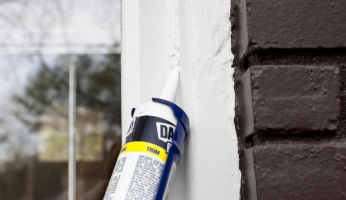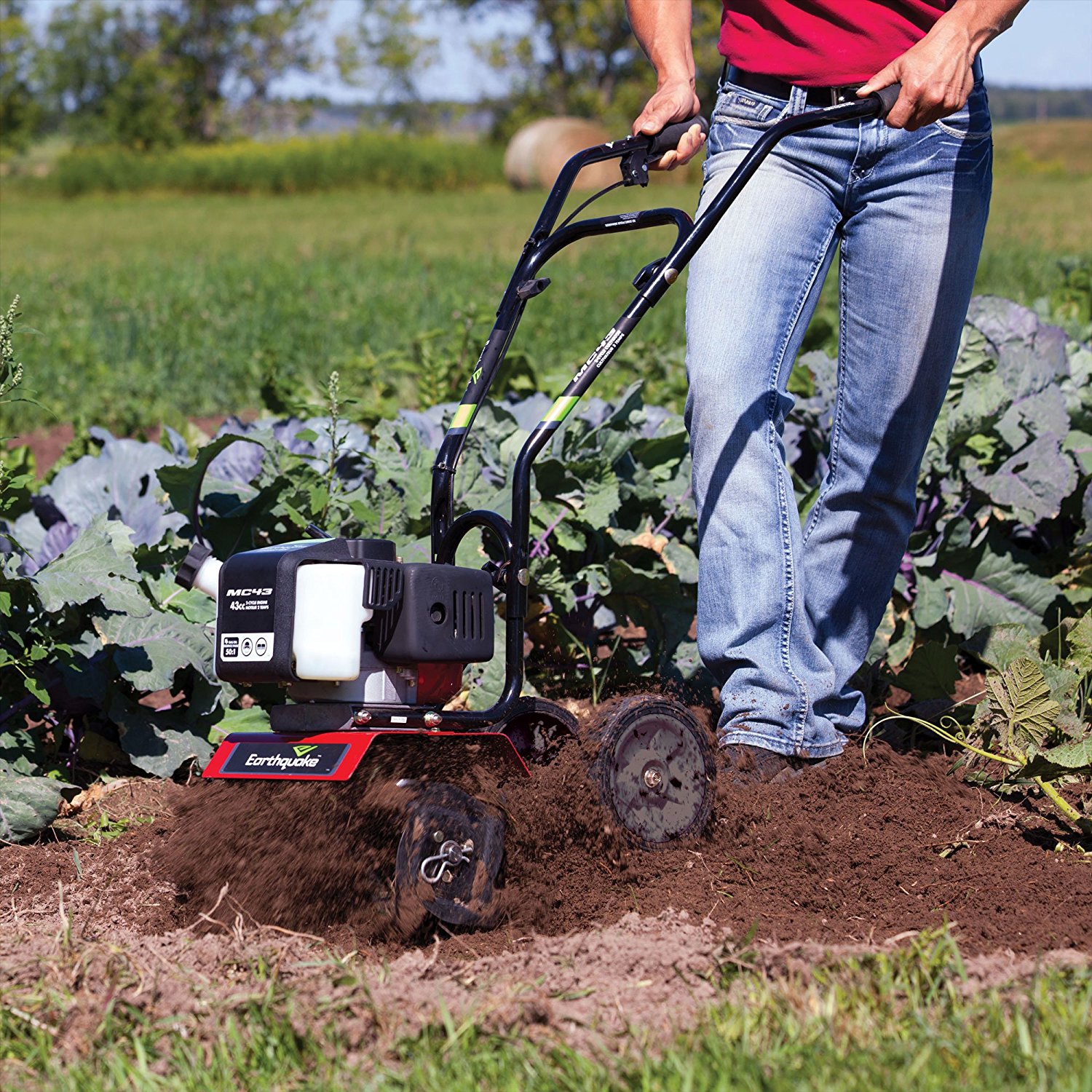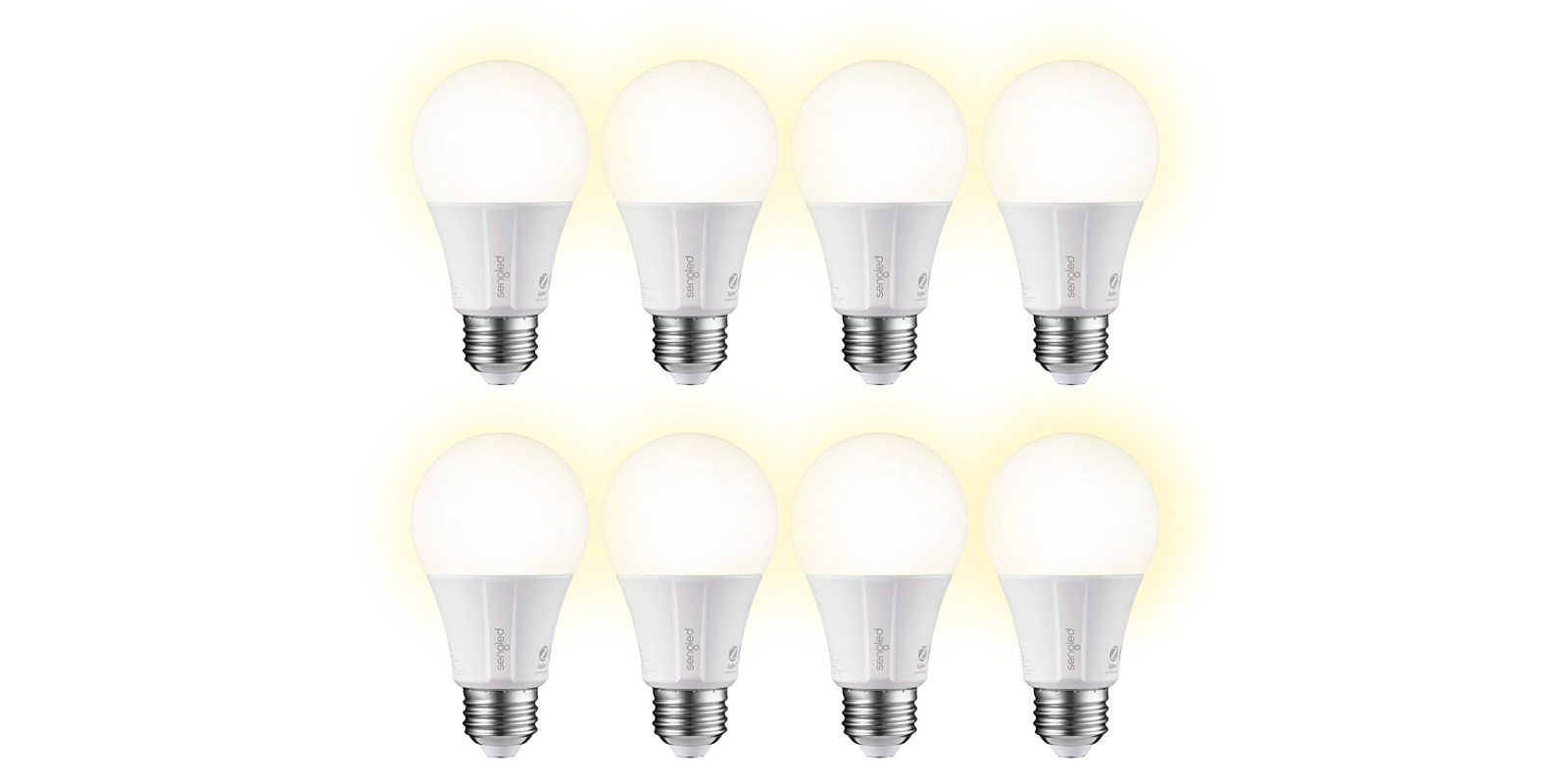- No Obligations
- Stop Paying Too Much For Your Contractor
- No Spam Calling
- Screened & ID Checked Contractors only!
Practical Ways to Get Rid of Small Animals in the Attic
0
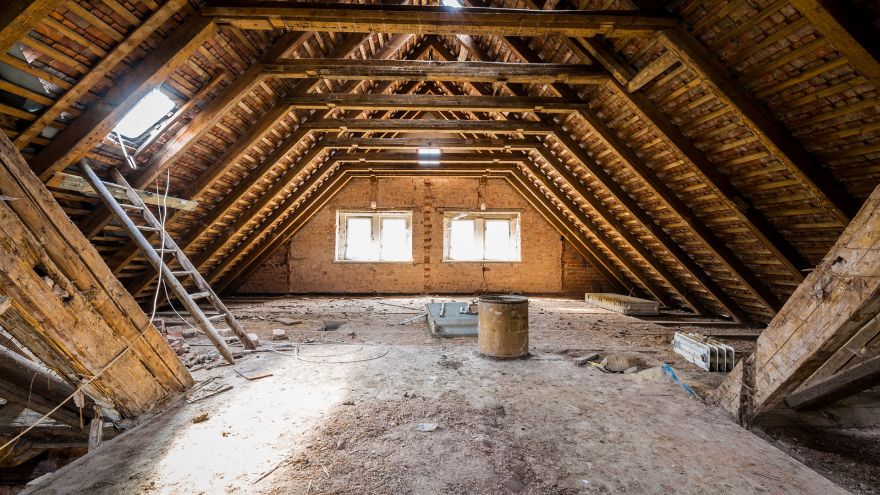 Practical Ways to Get Rid of Small Animals in the Attic
earlyexperts.net
Practical Ways to Get Rid of Small Animals in the Attic
earlyexperts.net
Lying in bed trying to get to sleep, and all you can hear is the sound of little feet scurrying above your head? If that’s you, then it’s very likely you have small animals living in your attic space. The likelihood is that rats, a raccoon or squirrels have managed to find a way into the warm space between your living area and the roof, although other animals are sometimes found up in the eaves.
Animals will often look for a warm place in the winter months, and any small opening is enough for them to make their way through. Every home has ventilation and gaps that can be opened up by animals. Rodents are very adept at gnawing away wooden fixtures to create enough space so they can get through the gap. If aluminum or vinyl cladding is not properly fastened then, animals can push it aside, creating a doorway to your attic. Rats need a hole no bigger than ½ an inch to enter a home. Once inside the animals can cause irreparable damage to wiring and other fixtures in the home. Squirrels, rats, and mice have constantly-growing teeth, so they need to gnaw on things to file them down. Any wiring, exposed woodwork, small-bore piping, becomes something easy to chew on. However, rodent damage can lead to electrical fires, leaks, flooding, or contaminated air conditioning systems.
Rats & Mice
Probably the most common animals found in attics are rats and mice. House mice can live just about anywhere and are the most commonly found in attics. There are two types of rats, the common rat, and the Norway rat. The Norway rat is predominately ground-based and lives in sewers and basements. The common rat likes to live inside buildings and tries to hide away, that’s why it can generally be found in the walls and attics of properties. In the warm, safe atmosphere of attic rats and mice can quickly breed so the infestation will grow exponentially. Once you realize you have rodents in the attic, the problem should be dealt with immediately. You will normally hear rats or mice scurrying around in the quiet of the night.
Rats are very adept at finding ways into buildings. They can sense a slight breeze coming from inside a property, and work on the hole so it is big enough for them to enter. As they are great climbers the hole could be high on the side of the building or low to the ground, so the outside of your home should be checked regularly for any defects or holes. Once inside rats, particularly will leave a trail of droppings all over the place. They also like to burrow into the warm attic insulation to create nests and trails.
Solution:
There are lots of hi-tech methods advertised, but none is proven to rid a home of a rat or mice infestation. Some people suggest poisoning, however, that can lead to more problems with the disposal of dead and decaying animals. The only sure-fire way of getting rid of rats and mice from an attic is to first close up any entry holes that allow the animals to get into the property. A thorough inspection of the outside of the building and the inside of the attic should give you an indication of where they are entering. Once this is completely sealed, then you can lay spring traps, and catch the rats and mice that way.
Squirrels
The other common rodent found in attics is the squirrel, and in the United States, the culprit is more often the Eastern Gray. With their long fluffy tail, the squirrel may look cute, but the expert climber loves to chew on just about anything. So just like rats and mice, it can cause structural problems when gnawing through wood, or a potential fire hazard when chewing electrical wiring. A warm attic is like a luxury hollow tree to a squirrel and is an ideal place to give birth and raise their young. Squirrels are creatures of habit and will return to the same attic year after year, creating more and more problems.
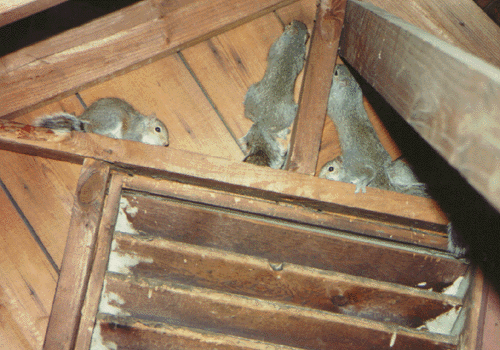
Squirrels are most active in the early morning, and at sunset, so this is when you are likely to hear them moving about in your attic. These rodents don’t need a large hole, as once they find one, they will more than likely gnaw it big enough so they can get through and enter the property. As they are great climbers, their entry hole can be anywhere on the side of a building or on the underside of the eaves. All they need is one hole which they will use time and time again. Most homeowners eventually realize they have squirrels in their attic in September or March, once the female has given birth and the young animals begin scampering around their new home.
Solution:
The only way to be sure of getting rid of squirrels is to have them professionally removed. This means they must be trapped and relocated. At the same time, the outside of the property needs to be thoroughly checked and any entryways or possible entrances plugged so they squirrels can not gnaw their way back inside. Once you have extracted the squirrels from the attic, then the area should be completely cleaned and disinfected, as their droppings can leave parasites behind, and the odor may attract other animals into space.
Raccoons
Raccoons are curious creatures and are known for their mischievous behavior. They have adapted well to living alongside humans, and regularly will raid trash cans for food, or steal food left out for pets. So, breaking into an attic for warmth and shelter is almost second nature to these wild animals. When the females are ready to give birth, they will seek out anywhere warm and dry so that attics can be ideal. Commonly, a female raccoon will be found in an attic with a litter of her young. An adult raccoon can with up to 25 lbs (10kg) and cause a great deal of damage in a small attic space.
As nocturnal animals, most of their movement will be at night, and as they are large then they make a heck of a noise when moving around. They can also be pretty vocal, so if you hear growling or chattering going on its most probably a raccoon. With such a large animal, they leave an obvious trail of entry, with large holes and droppings. Once a female raccoon has found an attic she may have a litter of young, and then stay on to have more.
Solution:
Raccoons are the visitors from hell, who will never leave unless you force them to. If there is one raccoon in your attic, then there will likely be more, so the whole area must be thoroughly searched. A professional pest controller will be able to trap the raccoons and have them safely relocated. Any holes need to be identified and closed; it is recommended that a metal plate is bolted in place to stop the animals getting back into the property. Once the raccoons have been removed, the area should be checked for damage and disinfected to remove the animal’s odor and not attract other unwanted visitors.
Opossums
Like the raccoon, female opossums look for a safe, warm environment to give birth and raise their young and an attic has all the right credentials. The animals are also great climbers, so can get into any hole in the side of a building and gain access to the roof space. Getting rid of an opossum and her young is easier than with a raccoon as the young cling to their mother while being reared. However, during the winter the solitary creatures sometimes den together, and you can get up to half a dozen adults living in the same space.
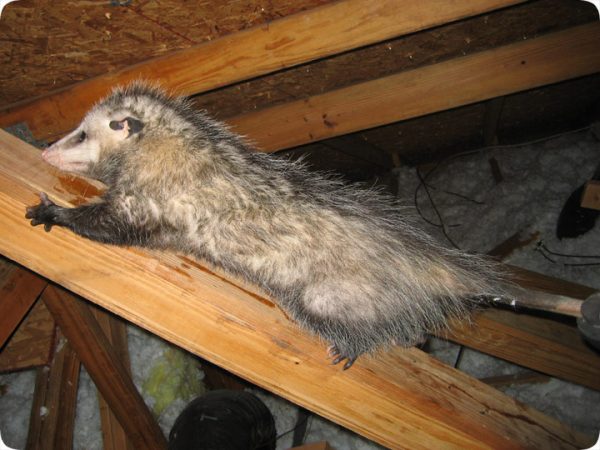
If any of the animals should die in your attic, you will soon know, as the smell can be incredibly invasive. As nocturnal animals, you will hear opossums moving around at night, but as slow-moving creatures, it may be difficult to differentiate their footfall from the other sounds around the home. They leave a lot of feces around the place, and the animals give off an odor which may be the first indication you have of these unwanted visitors.
Solution:
The tried and tested method of trapping is best for the opossum. As they are slow moves trapping is much easier than with other rodents found in attic spaces. They need to be removed to a safe location, and their entrances sealed. Putting a metal plate bolted down is a sure way of blocking them from returning to your property.
Bats
Removing a colony of bats from an attic is one of the most complicated wildlife control operations. In many places, bats are a protected species, and it is illegal to kill them. It can also be illegal to disturb a bat colony at certain times of the year, and the bats can only be touched by someone authorized in bat removal. Once bats find a place to call home, they will return there year after year, and the colony will only get bigger as the females have their young. So, it is advisable to get professional advice on controlling a bat colony as soon as it is discovered. A colony of bats can be very noisy, especially at night.
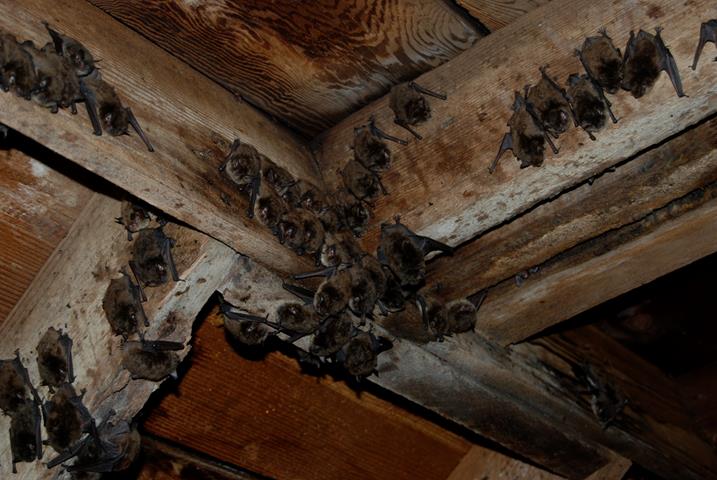
You may notice bats leaving and returning to your roof at dusk when they go out to find food. Bats usually look for small holes near the roofline of homes to find a nesting site. Bat droppings or guano can contaminate the atmosphere in an attic and has the potential to cause lung diseases in humans.
Solution:
Call in the experts, dealing with a bat infestation of your attic is not something you can tackle on your own. There are legal implications in many areas, and better to have a qualified bat expert deal with it than you get on the wrong side of the law. Sealing the building once the colony has been removed is vital to stop them returning.
Snakes
You may not think it possible, but snakes do find their way into attic spaces, as they can be attracted by other animals such as rats and mice. The Yellow Rat snake can sometimes find its way into your attic looking for baby rodents to eat. Although not venomous, if a snake takes up residence and gives birth, you will soon have snakes in the walls and all over the house. If your attic space has a rodent infestation, then the snakes will stay there as there is a ready food supply, so getting rid of the rodents should be the first step in getting rid of the snakes.
Solution:
The snakes are attracted to the smell of the rodents, so getting rid of the rodents and their smell will help drive them away. You can place snake traps in the attic to get rid of any stragglers. Once again, it is essential to identify where the snakes were getting onto the building and seal the entryways completely.


